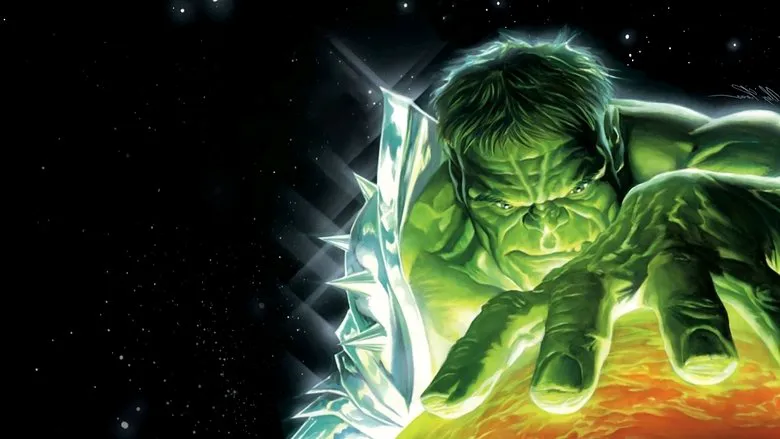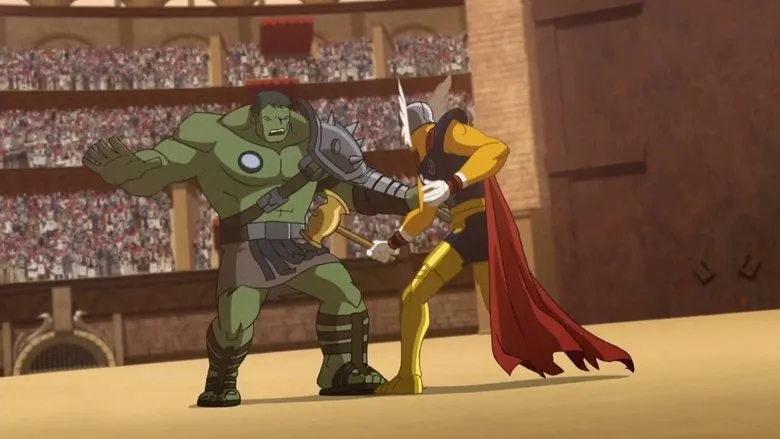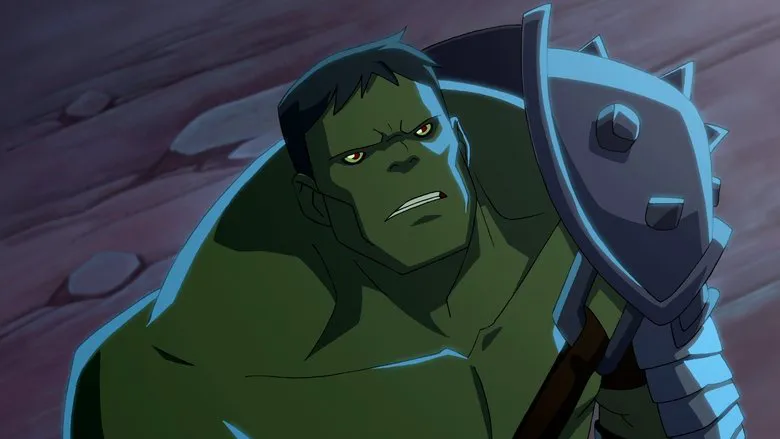Unpacking the Hidden Details in Thor: Ragnarok
Much like its Marvel brethren, Thor: Ragnarok is a treasure trove of hidden “Easter eggs” – sly references, inside jokes, and nods to the comics and wider pop culture. Join us as we delve into some of the most fascinating among them!

Melodies and Mythos
Surtur, The Diminished Fire Giant
The film opens with Thor confronting Surtur, a formidable fire demon prophesied to bring about Ragnarök. Initially, Surtur appears surprisingly weak, his colossal sword dragging, his movements slow and hobbled. This weakened state is a direct consequence of being separated from his Eternal Flame, a mystical source of power that Odin secured centuries ago during his unification of the Nine Realms. It is only through reuniting with this sacred flame that Surtur can unleash his true, terrifying potential. Muspelheim, Surtur’s fiery dimension, is one of the Nine Realms under Asgardian dominion, echoing the frosty domain of the Frost Giants.
The Myth of Frog Thor (Throg)
During the play, Damon’s Loki dramatically recalls a time when Thor was transformed into a frog. This seemingly absurd line is, in fact, a delightful Easter egg referencing a classic comic book storyline where Loki, in his mischievous ways, truly does turn Thor into an amphibious creature. The comics even feature a character named Throg, a human transformed into a frog who wields a splinter of Mjolnir, proving that even the most whimsical comic elements can find their way into the MCU.
Shady Acres Retirement Home
When Thor and Loki attempt to retrieve Odin from the nursing home where he was last sighted, they discover it has been demolished. A lingering shot of the address plaque reveals the name “Shady Acres” – a direct and humorous nod to the same quirky retirement facility featured in the beloved 1994 comedy Ace Ventura: Pet Detective, where Jim Carrey’s character resided.
Norway: The Cradle of Mythology
Odin’s poignant decision to spend his final moments in Norway holds deep significance. Historically and mythologically, Norway is the traditional birthplace of the Norse gods within human folklore. His death there symbolizes a return to the very roots of his being and the mythology he embodies, providing a serene and fitting end to the all-father.
Doctor Strange’s Sanctum Sanctorum
Thor’s visit to Doctor Strange leads him to 177A Bleecker Street, a location instantly recognizable to comic book aficionados. This is the precise address of Doctor Strange’s Sanctum Sanctorum in the comics, situated in New York’s Greenwich Village. The address itself is also a subtle tribute to the iconic 221B Baker Street, the renowned address of another famous fictional intellectual: Sherlock Holmes.
Thor’s Iconic Umbrella Disguise
Initially, when Thor disguises himself as a mortal on Earth, he ingeniously conceals Mjolnir by transforming it into an ordinary umbrella. This is a brilliant and faithful tribute to early Thor comics, where Thor, in his mortal guise as the infirm Dr. Donald Blake, would use his enchanted walking cane to transform into the mighty Thor. The umbrella concept was similarly used in Thor 1 as an Easter egg to the Donald Blake persona.
Skurge The Executioner: A Hero’s Redemption
Among the film’s most true-to-comic characterizations is Skurge the Executioner. Initially, a rather ordinary Asgardian warrior seeking validation, he aligns himself with Hela. However, when faced with the dire need of his people and the returning Thor, Skurge finds his courage. His eventual sacrifice, heroically wielding two M16s against Hela’s undead army, is remarkably consistent with his ultimate fate in the comics. Skurge’s arc beautifully portrays the unexpected hero lurking within an everyman.
The Mystery of the Two Infinity Gauntlets
The existence of an Infinity Gauntlet in Odin’s vault within Thor: The Dark World had long puzzled avid Marvel fans, as it seemingly contradicted the one wielded by Thanos. Thor: Ragnarok shrewdly addresses this discrepancy: Hela, upon entering the vault, explicitly points out that Asgard’s gauntlet is a “fake!” This clever retcon officially clears up any past continuity confusion.
The Champion Contest and the Elders
The Grandmaster, alongside the Collector (seen in Guardians of the Galaxy), are explained to be brothers, both “Elders of the Universe” – ancient and immensely powerful cosmic beings. To stave off boredom from their eons of existence, they entertain themselves with peculiar hobbies. The Grandmaster’s eccentricity involves orchestrating elaborate “Champion Contests,” pitting powerful individuals against each other for his amusement and to determine the strongest. Both Thor and Hulk become unwilling participants in these bizarre games.

Planet Hulk Influences
The Thor: Ragnarok storyline prominently features elements adapted from the acclaimed Planet Hulk comic book arc. From Hulk’s distinctive gladiator attire (which mirrors his “Green Scar” persona, a powerful iteration from the comics) to the intricate mind-control device used by the Grandmaster, countless visual and plot points are drawn directly from this classic comic saga, showcasing Hulk’s journey as a champion on a strange alien world.
“Celestial Group” Robots and Cosmic Connections
The various robots inhabiting Sakaar bear a striking resemblance to the Celestials, particularly the character Eson the Searcher, who appeared in Guardians of the Galaxy Vol. 1. This visual similarity isn’t coincidental; the Celestials were ancient cosmic entities active at the dawn of the universe, and the Grandmaster, also an Elder of the Universe, hails from a similar primordial era. This shared cosmic origin naturally leads to similar aesthetic tastes and technologies.
The Three-Headed Vampire Fork
When Thor and Korg are choosing weapons for the gladiatorial arena, Korg dismisses a trident, quipping, “Unless you’re planning on stabbing out three vampires with one stick, this Fork… it’s useless.” This quirky line is a direct and humorous nod to Waititi’s critically acclaimed mockumentary What We Do in the Shadows, which revolves around three vampire housemates.
Hulk’s Sakaarian Comrades: Korg and Miek
Accompanying Hulk and Thor when they escape Sakaar and journey to Asgard are the fan-favorite duo, Korg and Miek. These characters are direct adaptations of Hulk’s loyal “Warbound” companions from the Planet Hulk comic series, where they served as his steadfast allies through thick and thin. Interestingly, while the film portrays Miek as an endearing, quiet insectoid creature, the comic book version of Miek is actually the insidious mastermind behind the “World War Hulk” event, offering a stark contrast to his cinematic counterpart.
Grandmaster’s Champion Tower Statues
The exterior of the Grandmaster’s colossal tower on Sakaar is adorned with grand statues commemorating past champions of his contest. While the precise lineup can vary, the film’s version notably depicts, among others, a likeness of the Hulk (already a reigning champion), Beta Ray Bill (represented by a horse-faced champion, a nod to a fan-favorite worthy alien who once wielded Mjolnir in the comics), and potentially Ares to the upper right. These statues celebrate the formidable warriors who preceded Thor.
Stan Lee’s Cameo: The Cosmic Barber
Marvel legend Stan Lee continues his tradition of delightful cameos in Thor: Ragnarok, appearing as the eccentric barber who gives Thor his iconic short haircut. Adding a touch of dark humor, Thor notes the barber only has one working hand, a subtle gag referencing Stan Lee’s many “broken hand” gags he often used in autograph signings.
The Revengers
When Thor attempts to rally his makeshift team, he playfully pitches the name “Revengers.” While a clever corruption of “Avengers,” this name actually has an obscure comic book precedent: in the comics, the “Revengers” often refers to a villainous group formed specifically to oppose the Avengers.
“The Sun Is Pointing Down!”
This seemingly random phrase, frequently uttered by Thor in both the arena and later on the Quinjet, is a humorous callback to Avengers: Age of Ultron. In that film, Black Widow uses a calming verbal cue – “Hey, big guy, the sun’s getting real low” – to help Bruce Banner pacify the Hulk. Thor’s repeated, slightly misremembered attempt to use this phrase on Hulk in Ragnarok generates significant comedic effect, highlighting his earnest, albeit clumsy, attempts to connect with his friend.
Loki’s Schadenfreude
The moment Hulk unleashes his fury on Thor in the arena, Loki’s reaction is priceless – a mixture of delighted schadenfreude and a hint of shared experience. This is a direct callback to The Avengers where Loki himself was famously throttled and repeatedly smashed by the Hulk. His gleeful sneer, seemingly saying, “Finally, someone understands my pain!”, is one of the film’s funniest and most self-aware moments.
“Not His Biological Child”
A running gag surrounding Thor and Loki’s complicated relationship resurfaces in Thor: Ragnarok. In The Avengers, Thor clarifies that Loki is his brother, only to quickly backtrack and emphasize they are “not biological” upon learning of Loki’s heinous acts. In Ragnarok, when the Grandmaster questions their relationship, a weary Loki echoes this sentiment, “Not his biological child,” further underscoring their strained and often tumultuous dynamic.
Central to Thor’s character arc in Ragnarok is the loss of his right eye. This is a direct and pivotal tribute to the comic book event also titled Ragnarok, where Thor sacrifices his eye in exchange for the power of runes to defeat the forces destroying Asgard. While the films are “merciful” in comparison (as he only loses one eye, rather than the more gruesome comic version), this loss symbolizes a deep sacrifice and maturation. More importantly, it mirrors Odin’s own iconic one-eyed appearance due to his sacrifice for wisdom. The eye patch Thor wears at the end is visually identical to Odin’s, symbolizing not just a memorial to his father but also a powerful inheritance of Odin’s spirit, kingship, and wisdom.
The hapless “Cousin Carlo,” horrifyingly melted by the Grandmaster right in front of Thor, is named after Carlo Carriero, a visual development artist who worked on the film and is also known for his work on Hulk-related comics and projects, adding an insider’s tribute.

Where is the Soul Stone? An Infinity War Setup
Before Thor: Ragnarok’s release, many fans speculated that the Soul Stone, the last missing Infinity Stone, would appear within the film or Black Panther. While Ragnarok came and went without a trace of it, its absence solidified theories: the Soul Stone’s function (communicating with ancestors’ souls) likely makes Wakanda’s sacred ancestral plane in Black Panther its most fitting location. The film cleverly reinforces that it wasn’t here, setting up its eventual reveal.
Loki’s Secret: The Cosmic Cube
In a crucial, fleeting moment before placing Surtur’s skull into the Eternal Flame amidst the chaos of Asgard’s collapse, Loki’s gaze lingers upon the Cosmic Cube (Tesseract) within the vault. The scene then cuts away. This brief, almost unnoticeable act is a pivotal setup for Avengers: Infinity War, where Loki is seen possessing the Cosmic Cube. This confirms that Loki seized the Space Stone at that very moment, also explaining how he eventually appeared aboard Thor’s spaceship – most likely using the Cube’s spatial manipulation abilities.
Post-Credit Revelations
End Easter Egg 1: A Glimpse of the Mad Titan
The first post-credit scene of Thor: Ragnarok delivers a chilling preview of Avengers: Infinity War. As Thor and the Asgardian refugees journey through space, their spaceship is suddenly overshadowed by an enormous, menacing vessel – Thanos’s virtually invincible warship, the “Sanctuary II” (or “Temple II” as the director referred to it, distinguishing it from “Temple One” which Iron Man destroyed in Avengers 1). This appearance flawlessly sets the stage for Infinity War, explaining why Thor is later found drifting in space, why Loki holds the Cosmic Cube, and how Thanos swiftly acquires the Space Stone.

End Easter Egg 2: The Grandmaster’s Uncertain Future
The very last post-credit scene shows the Grandmaster, having somehow escaped Sakaar, confronting his former subjects. He mockingly declares his dictatorship officially “overthrown,” maintaining his eccentric charm even in defeat. As one of the universe’s powerful Elders (and the Collector’s brother), his fate remains delightfully open-ended. Given Marvel’s increasing focus on cosmic narratives in Phase 4 and beyond, the Elders of the Universe are poised to play a larger role. This enigmatic final scene leaves fans speculating about where the flamboyant Grandmaster will next appear – perhaps reunite with his brother, the Collector? – hinting at a larger cosmic canvas to explore.